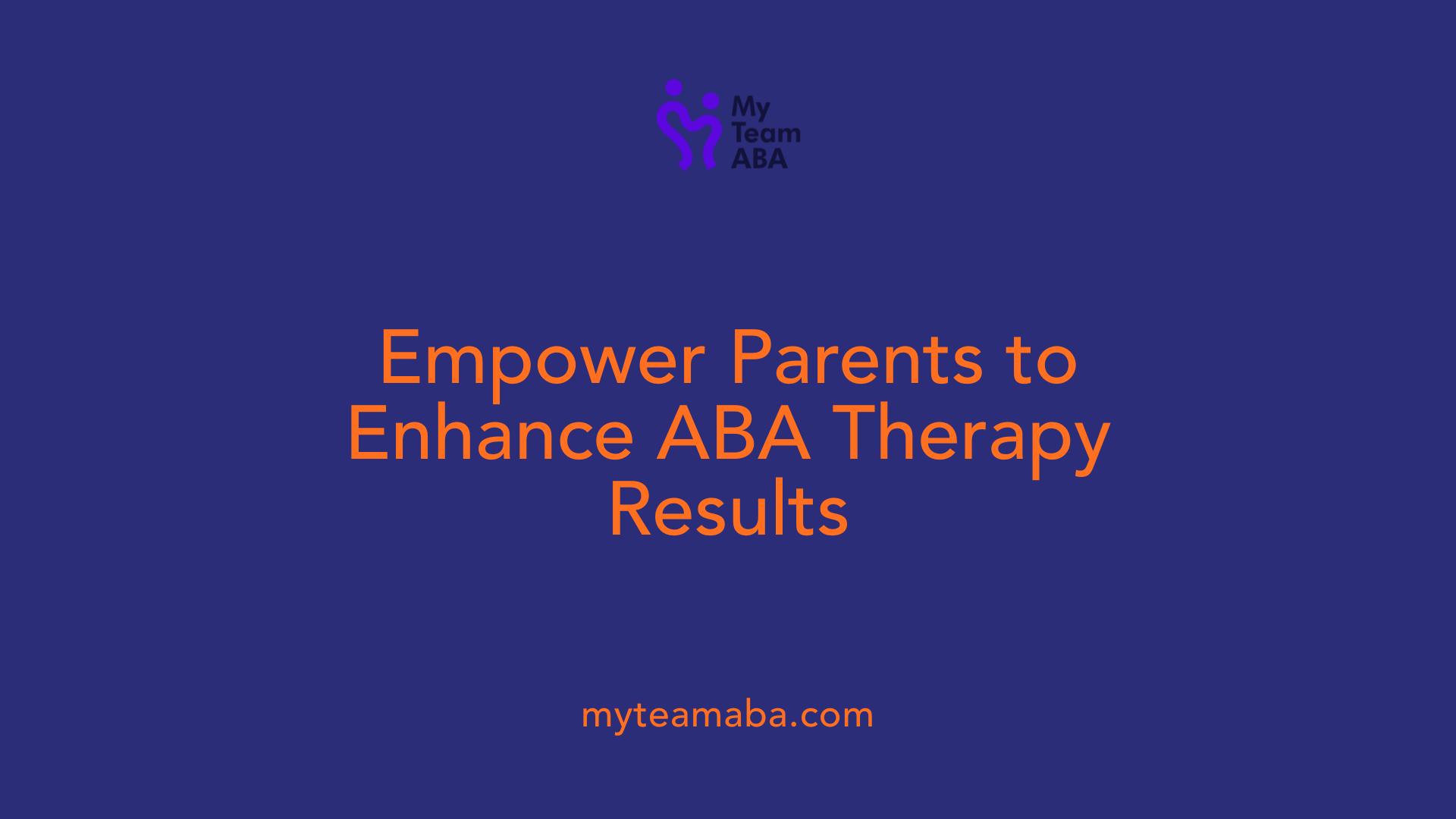The Importance of Parent-Teacher Collaboration in ABA Therapy
November 2, 2025
Building Bridges: Enhancing ABA Therapy Outcomes through Parent-Teacher Partnerships

The Critical Role of Family and Educational Collaboration in ABA Therapy
In the realm of ABA therapy for children with autism spectrum disorder (ASD), one of the most significant factors influencing successful outcomes is the collaboration between parents, teachers, and ABA providers. This cohesive partnership ensures consistency, personalized intervention strategies, and a supportive environment across home, school, and community settings. Understanding the importance of such collaboration can unlock better developmental gains and foster long-term success for children with ASD.
The Significance of Parent Involvement in ABA Therapy

Why is parent involvement in ABA therapy so important?
Parent participation plays a crucial role in the success of Applied Behavior Analysis (ABA) therapy. When parents are actively involved, they help ensure that children experience consistent support and reinforcement, which promotes the generalization of skills across different settings like home, school, and social environments.
One of the main benefits of parent engagement is the ability to tailor therapy goals to fit each child's unique strengths and challenges. This personalized approach is vital for fostering meaningful progress as it aligns treatment with the child's individual needs. Moreover, parents who participate in therapy learn strategies they can apply daily, reinforcing positive behaviors learned during sessions.
Active involvement also strengthens the emotional bond between parents and children. Providing positive reinforcement at home and being emotionally supportive create a stable environment that boosts the child's confidence and resilience. When parents understand and implement behavioral strategies, they contribute to emotional growth and help the child develop healthier social and emotional skills.
Additionally, engaged parents are better equipped to advocate for their children in educational, healthcare, and community settings. This advocacy ensures that children receive comprehensive support suited to their ongoing needs, further enhancing therapy outcomes.
Overall, parent involvement in ABA therapy not only maintains consistency in implementing strategies but also enriches the child's overall development. It creates a collaborative atmosphere that benefits the child's learning process and emotional well-being, setting the stage for sustained progress and successful skill transfer across various aspects of life.
Enhancing Child Development through Collaborative Efforts

How does collaboration between parents, teachers, and ABA providers improve children's development?
Working together, parents, teachers, and ABA providers create a consistent environment that reinforces learning and behavioral skills. This teamwork helps children apply what they learn during therapy across different settings like home, school, and social environments.
Open communication based on respect and understanding builds a strong partnership. It allows all parties to share insights, set shared goals, and reflect on progress regularly. These collaborative efforts ensure that strategies are tailored to meet each child's unique needs, strengths, and challenges.
Parental involvement is especially important because it enables caregivers to implement behavioral techniques outside of therapy sessions. This frequent reinforcement promotes skill generalization, making progress more noticeable and lasting.
Regular reflection and joint planning help adjust interventions as the child's needs change over time, resulting in more effective support. When everyone works towards common goals, children benefit from a cohesive support system that fosters learning, confidence, and social-emotional growth.
Ultimately, collaboration accelerates developmental gains and helps children develop independence. It also strengthens the relationships and trust among parents, educators, and therapists, creating a nurturing environment where children can succeed.
Best Practices for Fostering Effective Parent-Teacher Partnerships

What are best practices for fostering effective parent-teacher partnerships in ABA therapy?
Building successful collaborations between parents and teachers in ABA therapy involves several essential strategies. Consistent, respectful communication plays a foundational role. Regular updates about the child's progress, along with positive feedback, help strengthen trust and keep all parties aligned on goals.
Joint goal-setting and ongoing feedback foster a sense of shared purpose. When parents and teachers work together to set clear, achievable objectives, it creates a cohesive approach to supporting the child's development. This collaboration also encourages parents' active participation both at home and within the community, making skill generalization and maintenance more effective.
Training parents and involving them in the child's learning process boosts understanding and compliance with behavioral strategies. Active participation—such as attending meetings, practicing strategies at home, and reinforcing learned behaviors—ensures consistency across environments.
Overcoming barriers like language differences or scheduling conflicts is crucial. Providing resources, flexible meeting times, and translation services where needed contribute to sustained engagement.
Sharing successes regularly builds trust and motivation among everyone involved. Celebrating progress reinforces positive relationships and emphasizes the team's commitment to the child's growth.
In summary, fostering effective partnerships requires open communication, collaborative planning, proactive support, and mutual respect. This integrated approach enhances the child's ability to acquire, generalize, and maintain important skills, leading to better developmental outcomes.
The Impact of Family and Educational Team Collaboration on Therapy Outcomes

How does collaboration between families and educational teams improve therapy results for children with ASD?
When families and educational professionals work together, children with autism spectrum disorder (ASD) often see better progress. This partnership provides consistent and personalized interventions across different environments, such as at home and in school.
Shared assessment and goal-setting play a vital role. Families and teachers collaborate to develop and adjust goals based on ongoing observations and data collection. This ensures that strategies are aligned and effective, helping children generalize skills learned during therapy.
Parent training and ongoing support empower families to reinforce positive behaviors and strategies at home. By actively participating in their child's learning process, parents help sustain and build on progress. The communication established through training fosters a sense of confidence and competence within families.
Interdisciplinary collaboration among ABA therapists, educators, speech therapists, and occupational therapists creates a holistic plan for each child. These teams work together to address behavioral, communication, and sensory needs, ensuring comprehensive care.
This cooperative approach translates into long-term benefits. It supports continuous developmental progress, improves social-emotional skills, and enhances the child's ability to adapt across settings. Overall, teamwork between families and the educational system helps establish a nurturing environment that promotes sustained growth.
| Aspect | Description | Example |
|---|---|---|
| Consistency | Unified strategies across settings | Home and school behavioral plans aligned |
| Personalization | Tailored goals based on child's strengths | Customized communication goals |
| Support | Parent training and professional collaboration | Workshops for parents and staff |
| Monitoring | Regular progress updates and data sharing | Monthly team meetings |
Effective collaboration creates a stable support network, leading to improved therapy outcomes and a brighter developmental path for children with ASD.
The Role of Data and Continuous Communication in Therapy Success

How does collaboration between parents, teachers, and ABA providers improve children's development?
Working together, parents, teachers, and ABA providers create a unified approach that benefits children immensely. Consistent strategies and reinforcement across home and school environments help children generalize skills learned in therapy.
Open channels of communication allow everyone to share progress, challenges, and observations. This shared understanding helps tailor interventions to the child's current needs, making therapy more effective.
Parents who are actively involved through training and consistent practice can implement behavioral techniques outside of formal therapy sessions. This consistency reinforces positive behaviors and helps children apply skills in everyday situations.
Regular meetings for goal setting and progress review ensure that all team members are aligned. Adjustments based on ongoing data and feedback adapt strategies to suit the child’s evolving development.
The combined effort fosters a supportive environment that promotes development, builds social-emotional skills, and increases the child's independence. Overall, teamwork among parents, teachers, and ABA providers accelerates progress and enhances the child's learning experience.
Data collection and progress monitoring
Tracking progress through detailed data collection allows providers and families to see what strategies work best and where adjustments are needed. Accurate data helps inform decision-making and ensures interventions are targeted effectively.
Continuous monitoring offers immediate feedback to modify approaches, celebrate successes, and address challenges early. Collecting consistent data across settings also demonstrates the child's growth over time.
The importance of ongoing communication
Open and honest communication keeps everyone informed about the child's progress and any concerns. Regular updates through meetings, reports, or casual conversations create transparency.
This ongoing dialogue helps identify potential issues early, reducing setbacks and ensuring that interventions remain relevant.
Adjustments based on data and feedback
Flexibility is essential. When data shows certain strategies are less effective, teams can modify behavioral plans promptly.
Feedback from parents and teachers offers valuable insights, leading to more personalized and effective support.
Building a transparent, goals-oriented relationship
Clear goals and shared expectations help maintain focus. When all team members understand and agree on objectives, efforts are more coordinated and goal-focused.
Ensuring all team members are aligned
Training and collaborative planning sessions enhance understanding among parents, teachers, and providers. This alignment ensures consistency and reinforces skills across environments.
Effective collaboration through data and communication creates a stable foundation that accelerates children’s development and promotes successful outcomes.
Overcoming Challenges in Parent-Teacher Collaboration
What are the challenges of parent-teacher collaboration in ABA therapy, and how can they be addressed?
Effective collaboration between parents and teachers is vital for the success of ABA therapy, but several barriers can make this collaboration difficult.
One common challenge involves differences in communication styles and expectations. Some parents may prefer frequent updates, while teachers may have limited time for extensive communication. Language barriers can also impede understanding, especially in diverse communities where English may not be the first language.
Resource limitations pose another obstacle. Schools and families may lack the necessary materials or sufficient staffing to facilitate regular communication or joint training sessions. Scheduling conflicts further complicate participation, making it difficult to hold meetings or collaborative planning sessions.
To address these challenges, proactive strategies are essential. Establishing consistent and clear communication channels—such as regular emails, phone calls, or digital communication platforms—helps keep everyone informed. Offering translation services can bridge language gaps, ensuring all parties understand and participate fully.
Flexibility in scheduling is also crucial; providing options for meetings during different times or via virtual platforms can increase accessibility. Sharing training sessions on behavioral strategies allows both teachers and parents to develop a common understanding and approach.
Building mutual trust and understanding underpins effective collaboration. This involves empathetic dialogue, clear articulation of shared goals, and recognition of each other's efforts. Celebrating progress together and addressing setbacks as a team fosters a positive environment.
Maintaining engagement requires ongoing effort. Recognizing small successes, providing positive reinforcement, and working collaboratively to solve problems help sustain motivation. When setbacks occur, addressing them openly rather than avoiding issues encourages resilience.
In summary, overcoming collaboration challenges involves establishing open communication, providing support for diverse needs, being flexible with schedules, and cultivating a partnership grounded in trust and shared purpose. These strategies ensure that both families and educators work cohesively to support each child's development in ABA therapy.
Fostering a Unified Approach for Better Outcomes
The success of ABA therapy largely depends on the strength of the partnership between families and educational professionals. By fostering open communication, mutual trust, and shared goals, parents, teachers, and ABA providers can create a consistent and responsive environment that promotes meaningful progress for children with ASD. Investing in effective collaboration strategies enhances the child's ability to generalize skills and develop resilience in the face of challenges, ultimately leading to improved developmental, behavioral, and educational outcomes. Building this unified approach requires ongoing effort, empathy, and a shared commitment to the child's growth, making collaboration not just beneficial but essential for long-term success.
References
- The Importance of Parent Involvement in ABA Therapy
- Understanding Your ABA Provider's Partnership with Schools
- Family Involvement and Parent-Teacher Relationships for Students ...
- The Role of Caregiver Involvement in ABA Therapy
- Impact of ABA Therapy: The Key Role of Parental Involvement
- Helping Parents Understand Applied Behavior Analysis: Creating a ...
- Parent Involvement in ABA Therapy - Surpass Behavioral Health
- Parental Involvement in ABA Therapy for Children with Autism
- Tips Effective Parent-Teacher Communication During ABA Therapy
- Building Effective Parent-Teacher Relationships - GSEP Blog
